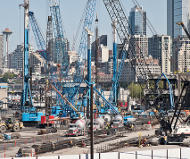7/20/2012
Washington: Toll Roads Re-Direct CongestionAnalysis of traffic patterns suggest toll road will divert congestion from freeway to side streets.

Imposing tolls on freeways and tunnels may not actually reduce congestion. An analysis of the Alaskan Way Viaduct replacement project by the Washington State Department of Transportation (WSDOT) suggest tolling merely takes the traffic that would otherwise have been on the high-capacity highway and transfers it to another, untolled route -- usually a lower-capacity side street.
WSDOT is replacing the Alaskan Way Viaduct with a tunnel that runs beneath downtown Seattle because it was built sixty years ago and suffered damage in a 2001 earthquake. The new tunnel will be much stronger and join with the new State Route 99 roadway south of downtown. To help pay for the $3.1 billion cost of the total project, WSDOT wants to toll the tunnel to generate revenue.
The analysis found between 30 and 40 percent of traffic abandons the tunnel when tolls ranging from $1 to $3.25 are imposed. An estimate of 2017 tunnel volumes predicted high toll scenarios would divert up to 64 percent of traffic. A $3.25 toll may not sound like much, but for a daily commuter that adds up to $1690 per year. To save that money, many will jump off the toll road.
"PM peak tolls caused some areas to experience more congestion: Alaskan Way, Western Avenue," a presentation to the Advisory Committee on Tolling and Traffic Management explained. "Southbound tolls resulted in higher diversion than we anticipated. Even modest mid-day tolls led to diversion."
At the same time, the agency denied that diversion necessarily means congestion. Under mid-day scenarios, travel times on side streets only increased by a minute or two. The 2017 projections estimate the SR99 tunnel would have mid-day traffic volumes of 4800, but when the tunnel was tolled, traffic falls to 2950 to 3250. The SR99 traffic did not disappear, between 1550 and 1850 cars moved to Alaskan Way, Interstate 5 and arterials near the freeway. Most of these side streets are not designed to handle the heavy capacity. In a rush hour scenario, 9100 cars are sent onto the side streets.
"When I-5 is congested, cars leave it for city streets east of the highway," the presentation explained.
WSDOT is so committed to tolling that the agency spent $18 million (including $5 million in US taxpayer funds) building the State Route 167 HOT lanes, only to operate them at a massive loss. The tide only turned last year with the road generating a net profit of $12,000.
Correction: The description of the tunnel project has been updated.


